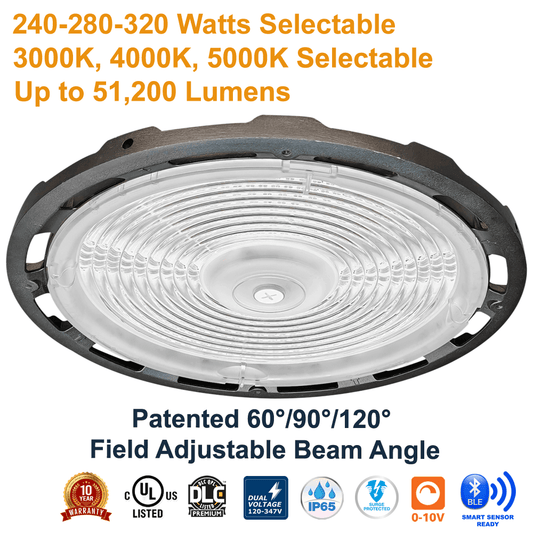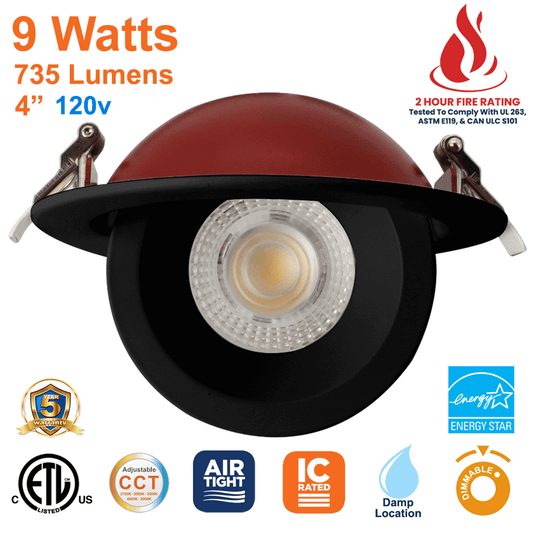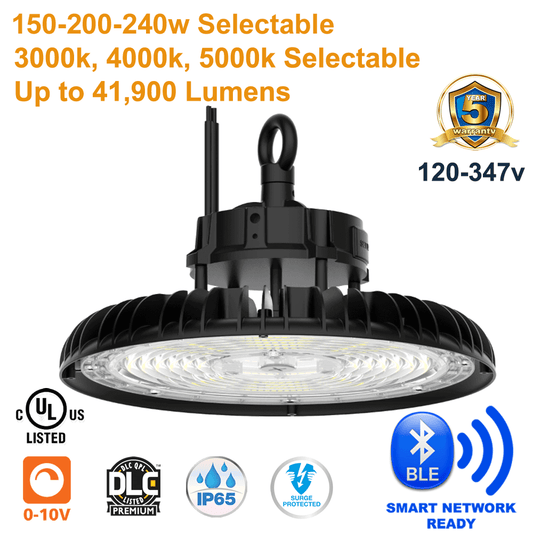What Are High Bay LED Lights?
We’re often asked what an LED High Bay Light is. But to better understand what they are, and the qualities of the best High Bay LED Lights, we should first step back to take a look at what High Bay Lighting is.
A High Bay Light is a type of lighting fixture used to illuminate large commercial, industrial, or warehouse spaces with ceilings 15 feet or higher. A High Bay Light Fixture is usually suspended from the ceiling by chains or conduit and is designed to provide lighting over a wide area.
Typically, the minimum suspended height of High Bay Lights depends on several factors. These include; the height of the ceiling, the light output of the High Bay, the specific lighting requirements of the space, and the High Bay’s light distribution (also known as beam angle).

As a general guideline, High Bay Lights are usually suspended at a height of 15 to 50 feet (4.5 to 15 meters) above the floor. However, the actual suspended height may vary based on the specific lighting needs of the space. For example, if a higher level of lighting is required in a particular area, the high bay light may be suspended lower.
What Kind of High Bay Lights Are There?
There are several types of High Bay Lights, including:
- LED High Bay Lights
- Fluorescent High Bay Lights, including the more recent T5 High Bay Lights, as well as older T8 and T12 High Bay Lighting
- HID (High-Intensity Discharge) High Bay Lights, such as Metal Halide (MH) and High-Pressure Sodium (HPS) High Bays
- Induction High Bay Lights
Each type has its own unique features, advantages and disadvantages, and the best choice depends on the specific lighting requirements of the space. But, as time marches on and technology improves, LED High Bay Lighting has become the most popular form of High Bay Lighting due to performance, longevity, and other factors.
How Long Has LED High Bay Lighting Been Around?
The first LED High Bay lights were produced in the early 2000s. The exact year of the first production is not specified, but the use of LED technology in industrial and commercial lighting has increased significantly since then due to its energy efficiency, long lifespan, and durability.
Are There Different Types of High Bay LED Light Fixtures?
There are two primary types of LED High Bay Light Fixtures: Circular (more commonly known as UFO) and Linear.
UFO LED High Bays: This type of High Bay Light, also referred to as a UFO LED High Bay Light, is circular in shape, and sometimes is installed with a dome-like design to control light distribution and give the aesthetic look of the old HID High Bay Light Fixtures. UFO High Bays provide broad and uniform lighting coverage and are commonly used in spaces with high ceilings and large areas to cover.

Linear LED High Bay: This type of High Bay LED Lighting is long and slender, and most often features a linear LED array. It provides directional lighting and is better suited for spaces with a narrow floor plan. Linear High Bay LED Light Fixtures are often used in applications where a specific area needs to be illuminated, such as an aisle or corridor.

Variations of UFO and Linear High Bay Lights also include Vapour Tight LED High Bays and Explosion Proof High Bays for hazardous area lighting.
The choice between circular and linear LED High Bay Lights depends on the specific lighting requirements of the space, the desired aesthetic, and the desired lighting effect.
What Are The Benefits Of High Bay LED Lights?
No matter the type of High Bay LED you opt for, it will deliver several benefits when compared to other types of High Bay Lighting, including:
- Energy Efficiency: LED High Bay Lighting is highly efficient and uses less energy than traditional lighting sources. When replacing HID High Bays, energy savings are usually 65% or better.
- Long Life Span: LED High Bay Fixtures have a longer lifespan compared to traditional lighting sources and maintain their brightness for much longer.
- Elimination of Maintenance and Repair Costs: High Bay LED Lights do not require the ongoing maintenance associated with traditional High Bay Lighting. There is no need for ballast or lamp replacement, which delivers on-going savings beyond energy reduction.
- Instant On/Off: Commercial High Bay LED Lights turn on and off instantly, making them ideal for industrial applications where lights are frequently turned on and off.
- Better Light Quality: LED High Bay Lighting provides better colour rendering and a brighter, more even light compared to traditional lighting sources.
- Reduced Heat Generation: High Bay LED Lights generate less heat compared to traditional lighting sources, making them safer and more environmentally friendly.
- Improved Durability: UFO LED High Bay Lights are more durable and resistant to shock and vibration compared to traditional lighting sources.
- Dimmable: LED High Bay Lights are now most often dimmable, allowing for greater flexibility in controlling the lighting in a space. This flexibility increases with the addition of Networked Lighting Controls.
Overall, LED high bay lights offer several advantages over other types of high bay lighting, making them a popular choice for industrial and commercial applications.
How Do You Dim LED High Bay Lighting?
One of the most popular features of today’s LED High Bays is dimming, which can be done in several ways:
- Wired 0-10V dimming: This method uses a 0-10V dimming control circuit to regulate the voltage applied to the LED driver, which in turn controls the light output of the LED High Bay.
- PWM (Pulse Width Modulation) dimming: This method uses digital signals to adjust the brightness of the LED High Bay. A dimming controller sends pulses to the LED driver, which changes the amount of power supplied to the LED, resulting in a change in brightness.
- DALI (Digital Addressable Lighting Interface) dimming: This method uses a digital communication protocol to control the brightness of the LED High Bay. A DALI controller sends signals to the LED driver, which adjusts the brightness in response.
- Wireless 0-10V dimming: This method uses a wireless dimming control system to adjust the brightness of the LED high bay. A wireless dimmer sends signals to the LED driver, which adjusts the brightness in response. Newer networked lighting controls technology allows High Bay LED Lights to work together in groups, light levels will increase or decrease based on occupancy and ambient lighting conditions.
It is important to choose the right dimming method for your High Bay LED Lights, based on the type of LED driver used and the specific dimming requirements of the space.
What Does Beam Angle Mean?
The beam angle of a High Bay Light determines the spread of light from the fixture and has a direct impact on its lighting performance.
- Narrow Beam Angle: A narrow beam angle provides focused, directional light that is ideal for illuminating specific areas, such as workstations or aisles. This type of lighting is often used in applications where a higher level of light intensity is required. Linear LED High Bay Lights are preferred when a very narrow beam angle is required.
- Wide Beam Angle: A wide beam angle provides a broader spread of light that is ideal for general illumination. This type of lighting is often used in applications where a more uniform distribution of light is required, such as in large open spaces. UFO High Bay Lights are the more popular option when a wide beam angle is required.
The choice of beam angle depends on the specific lighting requirements of the space. A narrower beam angle provides a higher level of light intensity, while a wider beam angle provides a more uniform distribution of light. It is recommended to consult with a lighting professional to determine the best beam angle for your specific application.

How Long Can I Expect High Bay LED Light Fixtures To Last?
LED High Bay Lights have an average lifespan of 50,000 to 100,000 hours, although some newer models have the potential to last even longer. Several factors can affect the lifespan of a High Bay LED Light, including:
- Quality of components
- Operating temperature
- Power supply/driver quality
- Usage patterns
- Environmental conditions
Poor quality components, high operating temperatures, and poor driver quality can shorten the lifespan of LED lights. Heavy usage and exposure to harsh environmental conditions can also affect the lifespan.
The quality of components in an LED high bay light affects its:
- Performance: High-quality components ensure the light provides efficient and consistent illumination.
- Durability: Good quality components increase the lifespan of the light, reducing maintenance and replacement costs.
- Safety: Poor quality components can cause electrical malfunctions, which can be dangerous.
- Energy Efficiency: High-quality components help optimize energy consumption, reducing overall energy costs.
- Reliability: Components that are made to high standards reduce the risk of failures, ensuring dependable operation.
How Can I Tell The Quality Of An LED High Bay Fixture?
To determine the quality of LED High Bay Lights, consider the following factors:
- Brand reputation: Choose well-established brands with a good reputation for producing high-quality products.
- Certifications: Look for certifications like cUL, cETL, and DLC, which indicate that the Bay Light has been tested and meets industry standards for performance and safety.
- Materials: Check for high-quality materials like aluminum for heat dissipation, impact resistant lenses, and durable components for long-lasting performance.
- Driver quality: The LED driver is responsible for converting and delivering power to the LED chips, look for high-quality, high-efficiency drivers.
- Warranty: A good warranty is an indicator of confidence in the LED High Bay Light’s quality and longevity.
- Price: While a lower price may be tempting, quality LED High Bays tend to cost more upfront. Be wary of lights that are significantly cheaper than others on the market as they may not be made to the same standards.
We work with leading Canadian-based manufacturers to deliver high-quality industrial and commercial grade LED High Bay Lighting. View our selection of LED High Bay Lights here. If you’re working on a High Bay LED Lighting project, contact us by email or call us at 1-800-610-6112, we’re here to help.























